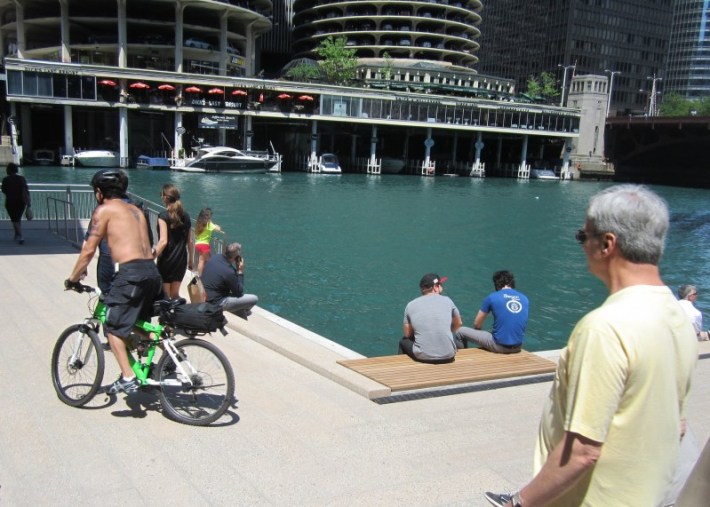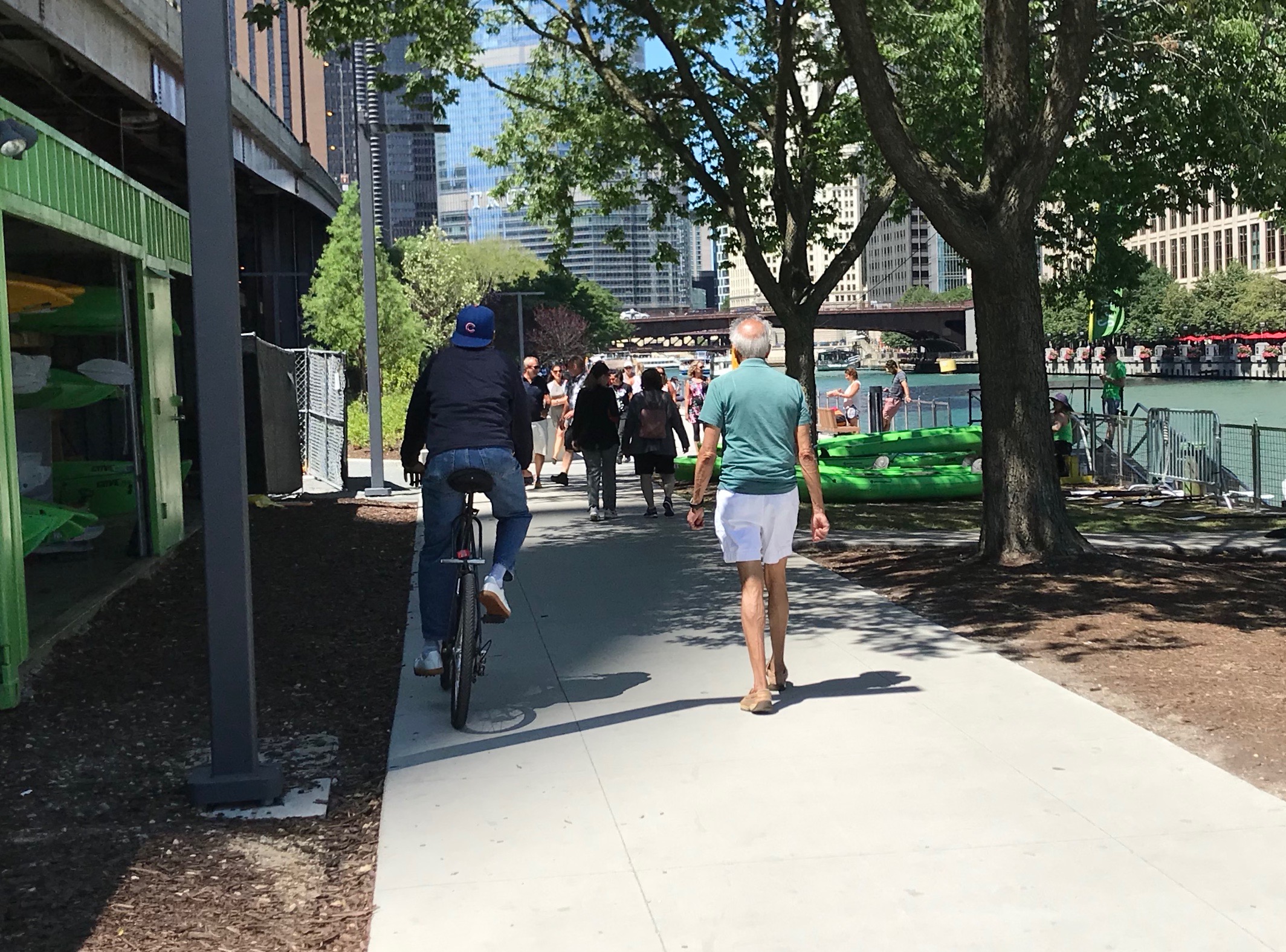By now frequent Streetsblog readers know the whole surreal saga of 42nd Ward alderman Brendan Reilly's crusade to ban biking on the Chicago Riverwalk, which the city promised the federal government would “enhance safety… with bicycle paths... along the continuous promenade” in order to secure a $99 million loan to build it. Otherwise, read this article to get up to speed.
Thanks in part to Streetsblog's tireless (obsessive?) coverage of the issue, the riverwalk management recently stopped ordering security guards to incorrectly tell people that it's illegal to bike there, since Reilly's proposed bike ban ordinance hasn't passed yet. But, don't worry, nowadays the guards are keeping busy incorrectly telling people that it's illegal to breastfeed there.
Last month, the Department of Fleet and Facility Management (2FM), which oversees the promenade, handed over a trove of emails about the biking ban in response to my Freedom of Information Act request. The documents revealed that last September after Reilly introduced his riverwalk ordinance, the Chicago Department of Transportation sent F2M a memo opposing the proposal for a 24/7/365 prohibition, calling it "too extreme." Another internal memo showed that even F2M had concerns, stating "An outright prohibition of [biking] on the riverwalk is inconsistent with the position previously represented to the federal government" that the facility would allow biking.
I took a deeper dive into the thick stack of emails this afternoon and discovered a few more interesting factoids about what happened before and after Reilly introduced the ordinance last year. Emails show that in July 2018, in response to complaints from residents in the affluent ward, the alderman's office was pushing hard for installing signage telling bicyclists they can't ride on the riverwalk, replacing the previous, appropriate "Bikes: Yield to Pedestrians" placards. "Would you please provide an update?" wrote Reilly's assistant Robert Kearney to F2M project manager Michelle Woods in a July 13, 2018, message. "I am getting a lot of calls from constituents about this matter."

On July 19, 2018, Woods wrote Kearney that the "Share the Riverwalk: Walk Your Bikes" signs were in fabrication. Interestingly, she added that the city was planning to stencil "Walk Bikes on the Riverwalk" on entrance ramps to the promenade. The emails don't reveal why the pavement markings were never installed.
Also interesting: Later that month on July 30, 2018, South Shore Line commuter railroad official Nicole Barker wrote Woods to say that, due to the railway's Bikes on Board program, customers had been asking how they can get from the Millennium Station platform to the Lakefront Trail without carrying them upstairs to Randolph Street "or using the creepy, gross elevator just outside the [Chicago] Cultural Center. We have an egress that goes to Lower Wacker Drive, and my team tells me you can ride to the lakefront from there, but I don't know how." She asked if the railroad could work the city of Chicago to identify a good route, and possibly install wayfinding signs.
"There's no short answer for you now, sadly!" Woods replied. "Lowest and mid-level Wacker are so gross and dark, which might make it really dangerous for biking." She added that the riverwalk wasn't a potential solution, because the city was discouraging people from riding on it.
Among the F2M emails was an August 10, 2018, letter from Reilly to attorney Jeffrey Graubart, an attorney who spilts his time between Chicago and northern California, apparently in response to a complaint from the lawyer about cyclists on the riverwalk, notifying him that the "Walk Your Bikes" signs had been installed. "Furthermore, I am working with riverwalk security and the Chicago Police Department to enforce the... policy."
It's worth nothing that in 2017 Graubert was fighting a very similar battle for riverwalk access as the one bike advocates are currently waging. After a security guard told him he couldn't walk his dog on a section of riverwalk near his 31st-floor Canal Street condo because the promenade was private property, he filed a FOIA request of his own that revealed the land was city property and should be open to leashed dogs during normal park hours. So it's pretty ironic that Graubart tried to stop cyclists from exercising their legal right to use the Chicago Riverwalk.
In an August 22, 2018, letter from F2M commissioner David Reynold to Reilly, the commissioner assured the alderman that riverwalk "contract security officials [the yellow-shirted security guards] have been instructed to enforce the policy for walking bicycles on the riverwalk." Shortly after that, cyclists began reported that the guards were stopping them and telling them they couldn't ride on the promenade.
On September 4, 2018, I reached out to CDOT spokesman Mike Claffey, noting that the "Walk Your Bike" signs and enforcement policy seemed to be inappropriate, since the riverwalk was originally pitched to the feds as a bike/ped facility. In their discussions about how to respond to me, Woods wrote Claffey, "Riverwalk west of Michigan [the new section] was never designated as a bikeway... the hard turns at each underbridge were intentional to discourage biking."
Gee, that's funny, because at at a 2013 community meeting prior to construction, Woods fielded a question on whether the plan incorporated bicycling and said cyclists would be welcome on the riverwalk. “What I anticipate is that early in the morning, commuters that use the Lakefront Trail will probably use [the riverwalk] as a bicycle path, which frankly I am fine with them doing.”
Moreover, when I interviewed Gina Ford, a landscape architect at the design firm Sasaki, which helped plan the riverwalk, in June 2015, she told me the exact opposite as Woods about the reason for the geometry of the riverwalk at the bridges. "We did a couple of really subtle things [to facilitate cycling.] Rather than making most of the turns exactly ninety degrees, most of them are slightly more obtuse of an angle.”

Claffey and Woods didn't respond to my inquiries, so I wrote a post advising cyclists to ignore the invalid "Walk Your Bike" signs. Shortly after that, a former CDOT employee who came up with the wording of the signs, told me the placards were installed after a guards told a bicyclist to walk his bike on the riverwalk, and the cyclist responded by angrily contacting the mayor's office threatening to sue the city. The former CDOT staffer stressed that this wasn't hearsay, but rather that he had a series of conversations with Woods about the matter.
But after my post about that crazy story came out, on September 6, 2018, Woods forwarded the article to her boss, Commissioner Reynolds, insisting that "the backstory portrayed is not accurate."
"This guy seems like a pretty militant biker," Reynolds responded, referring to yours truly. "I wouldn't be too concerned."
On September 7, 2018, Woods forwarded my article about the backstory to the 42nd Ward. On September 20 Reilly introduced the bike ban ordinance, and the rest is history. While Reilly has promised to pass his legislation by the end of the summer (although he's softened his position a bit recently), Streetsblog will stay on top of this issue and do our best to make sure that doesn't happen.





